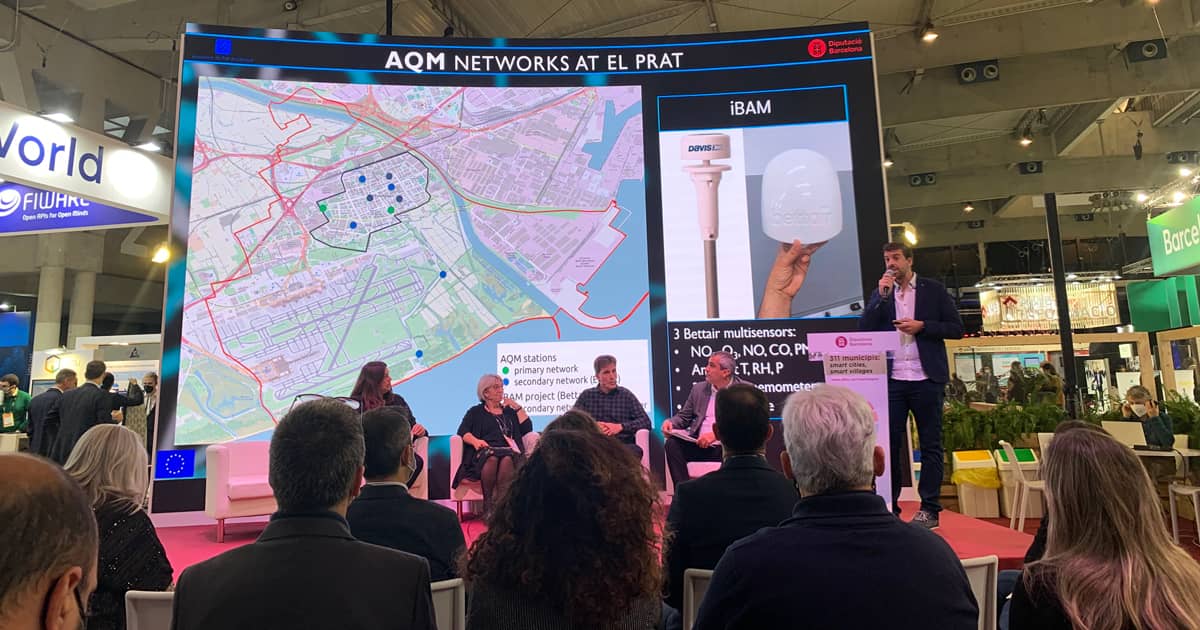When it comes to air quality, cities that attract heavy industry are often some of the biggest victims. For the municipality of El Prat de Llobregat, just outside of Barcelona, air pollution is a huge problem. The area is an attractive place for industry, largely because of the region’s location: it’s sandwiched directly between the bustling Barcelona Airport on one side and the restless Port of Barcelona on the other. While industry often brings wealth to a region, it also brings its fair share of challenges.
To learn more about the challenges facing El Prat, I caught up with Joan de la Paz Sanchez, the Smart City lead for El Prat, and Sebastiano Meneghello of Bettair Cities. The government of El Prat and Bettair Cities have teamed up to help the citizens of El Prat catch a much-needed breath of fresh air. Here’s what I learned.

Joan, Sebastiano, thank you for joining me here in Barcelona. Before we get started, if you could just introduce yourself and tell us who you are.
Joan: My name is Joan de la Paz, and I’m the CDO of the municipality of El Prat de Llobregat. I’m the main person responsible for all smart city projects in the district.
Sebastiano: My name is Sebastiano Meneghello, and I am the VP of Business Development at Bettair Cities. We are a company that has developed a platform that allows cities to map the quality of the air with a resolution that was previously unimaginable.
Joan, I’ve just watched you talk on stage, and you gave a wonderful presentation about your municipality, but unfortunately, my Catalan isn’t what it used to be. If you could, I’d love to know a little bit about El Prat de Llobregat.
Joan: El Prat is a small area with a population of about 63,000. It’s a small place, and the centre of the town is only about 3 square kilometres in size. The important thing to mention is that this area is right next to Barcelona airport, and of course, we are also located directly next to the Port of Barcelona. We are the only area in the region that is truly sandwiched between land, sea, and air!
It sounds like an exciting location, but I’m sure the proximity to the airport and port can bring its fair share of challenges as well as rewards, right?
Joan: Absolutely. We have a strong economy, but the location does present some environmental challenges. For example, we have some problems with pollution from the port area. We have a great number of companies and industries who are attracted to the region because of the proximity to the port, and that brings pollution with it. Obviously, the airport also adds to this problem, with planes taking off and landing around the clock. So, we deal with a wide range of different types of pollution, from the usual side-effects of being an industrial region to the less obvious but no less damaging effects of noise pollution from planes.
Air quality is a fairly hot topic at the moment. How bad would you say that the air pollution is in El Prat? How is it affecting citizens?
Joan: At the moment, we are not exceeding the maximum amounts. By that, we mean we are under the legal limit. But we don’t know if that’s because of the pandemic or if other factors are affecting the score. Even so, it doesn’t matter if we’re under that amount, it is still important for us to measure it and reduce it. Not only are we on the coast, but we’re also near rivers and other places that need protection. Of course, we need to protect our citizens the most.
For example, with pregnant women, air pollution can be particularly harmful. By having this information and controlling the levels of air pollution, we can make lives better for our residents and protect those who are most at risk by giving them the data to make healthy decisions.
Taking measurements seems to be the key to developing any practical environmental strategy. How are you currently monitoring the situation? From your presentation, I saw that El Prat has a number of Air Quality Management Stations (AQMS). How many do you have and what exactly do they do?
Sebastiano: Air Quality Management Stations or BettAir Measurement devices?
Both!
Joan: Currently, we have two primary Air Quality Management Stations from the Generalitat, so from the central government, but now we have five additional sensors that are the property of the El Prat Council, and we have four sensors provided by Bettair Cites, with three anemometers. I think in total we have 10 sensors in a three square kilometre area.
That’s quite a lot for a small area. With the Bettair Cities sensors, what exactly do they measure? Just particulate matter or is there more to it?
Sebastiano: The device focuses on pollutants that are directly harmful to the health of the citizens. So, this would include every gas that comes from combustion engines, including NO2, O3, CO, and of course, particulate matter.
We also measure ambient noise. This was actually a direct request from the cities we work with. They are always very interested in noise pollution. In the case of El Prat, it’s particularly interesting because of the airport.
We track all of these with our advanced devices, and we use the data gathered to produce a second layer of measurement that gives a picture with a much higher resolution than the images and data produced by the two Air Quality Management Stations of El Prat. This is worth mentioning because El Prat is an exceptional place that has the benefit of two Air Quality Management Stations. Most cities do not even have one.

No instruments at all?
Sebastiano: Not even one. El Prat has these Stations because of the airport and the port. It’s a particulate-rich area. But almost all other cities need to rely on data that comes from stations that are kilometres away from where people actually live. Seeing this, it becomes very clear that the data that they produce does not represent the air that people are actually breathing in the cities.
With the data gathered, is it freely available to citizens? Can it be accessed by anyone?
Joan: Currently, we are publishing the results on a platform where users can see a full history of the measurements and the evolution of the air quality in real time.
And is that data being used to create any models or digital twins?
Sebastiano: You can use this data in many ways, but it depends on who is accessing the data. Currently, the public administration often uses this to get a more detailed view of the quality of the air but without being able to make understandable visualizations, that data is fairly useless to the average citizen. By making this data visual, citizens can see that their actions can help to reduce pollution directly, or that they can make changes to their lifestyle to avoid certain situations.
That leads me to my next question: how does measuring the air directly make life better for citizens? Can you give me a real success story about how measuring air quality has had a positive effect on a citizen?
Sebastiano: Certainly. There are so many positive outcomes of this project. We can talk about the burning of biomass…
Joan: Sahara sandstorms! That’s another great one. Sahara sand can really cause trouble here. A good example could be when Sahara sand episodes or the burning of biomass, these really affect the town. We can measure the particulate in real-time and give that data directly to citizens.
So, if you see that the levels of particulates are particularly high, you might decide not to go for a run on this day, or maybe you decide to go for a run somewhere else in town that’s unaffected by the burning or Sahara sand. You see, data like this is important for the daily lives of the citizens in El Prat.
Small details like this help citizens walk around the city in a way that’s healthier and safer. Governments and politicians need to be aware of this and see how beneficial small measurements like these can be. Small measurements can have a big effect on the daily lives of our citizens.
It’s nice to hear an answer that’s not all about data. I always find that it’s very important for citizens to know exactly how this data could or is already improving their lives.
Sebastiano: I absolutely agree. These numbers don’t mean anything unless you can apply them to real life, no? And this is what El Prat is doing. It’s using a lot of data, a huge amount of data in fact, but it’s using that data to create value and find solutions to real, everyday challenges.
It sounds like El Prat is quite special, given its location and abundance of air quality sensors. Is this a project that other cities should be learning from, and are there plans to replicate El Prat’s success in other Spanish cities?
Joan: Absolutely. Other cities have been looking at our data and the models that we have been generating. We have a 3D model, and we’re using machine learning to help predict certain pollution events. Other cities are very interested in what we’re doing.
Sebastiano: In the case of El Prat, we’re doing something new. We are not just installing several sensors. Instead, we’re ingesting external data, including the topography of the buildings in the town, measuring wind, and traffic, to create a heat map that can really understand the difference in air quality between one node and another. It’s a real map. A smart map. By making this model, we’ll be able to replicate this in more cities, especially those with similar topography and similar challenges to El Prat.
It’s a project that we’re developing, together with the city, to make something completely new and exciting.
So, El Prat is something of a pioneering place then?
Joan: It certainly is. We are very proud of what we have accomplished and what we will accomplish in the future.
Join the global smart city network and community to discover Bettair Cities and other air quality monitoring and smart city solutions. Share solutions and knowledge with thousands of smart city experts and peers worldwide.


